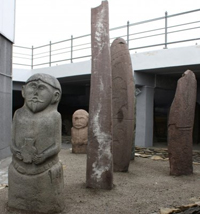|
 The ancient stone images that were brought to the National Museum of Tuva over the years from different corners of the republic are now on view by all those who wish to see them. In the stelarium of the museum, which is located on the ground floor, fifty-five stone figures are exhibited in chronologic order, starting with the Bronze Age to the Mongol period of Tuva. These are stones with images of animals, masks-faces, reindeer stones, stelae with ancient Turkic runic writing, stone human figures (kizhi-kozhee). There are also reference materials, archeological map of Tuva, materials on the Uighur fortress Por-Bazhyn, and on towns of the Mongol period of Tuva. The ancient stone images that were brought to the National Museum of Tuva over the years from different corners of the republic are now on view by all those who wish to see them. In the stelarium of the museum, which is located on the ground floor, fifty-five stone figures are exhibited in chronologic order, starting with the Bronze Age to the Mongol period of Tuva. These are stones with images of animals, masks-faces, reindeer stones, stelae with ancient Turkic runic writing, stone human figures (kizhi-kozhee). There are also reference materials, archeological map of Tuva, materials on the Uighur fortress Por-Bazhyn, and on towns of the Mongol period of Tuva. The stone stelae were earlier stored in the back courtyard of the old museum building.
In June 2009 they were moved to the new building. This extremely heavy load was at first arranged as an open-air exposition by the employees of the museum and the artist Valeriy Yelizarov ( yelizarov.ru ) . In the stelarium, there are guided tours in both Russian and Tuvan languages, which take 20 minutes in winter and 40 minutes in the summer.
In the future, the stelarium will be located on the museum territory, after a decision to fence off the territory surrounding the museum. In the same fenced-off area, there will also be a museum-farmstead “Tuvan aal” with around the year working yurt.
Kizhi-kozhee (stone figures) are one of the most interesting monuments of ancient Turks in Tuva. They are sculptural depictions of warriors with ritual vessels in their hands. There has been about 200 of these figures found in the expanses of Tuvan steppes and mountains, apparently objects of worship. The English traveler Douglas Carruthers astutely noticed that these stone figures were identical to “any colonel of the British Army, from the well combed, parted moustache, to the real military bearing”.
|
|
